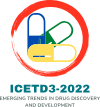Speaker
Description
Tuberculosis (TB) is a major global health problem that causes morbidity and mortality in developing countries. TB is one of the significant causes of death worldwide from single infectious agents after covid19, ranking above HIV/AIDS. It is estimated that one-third of the entire human population is infected with this disease. In 2020, there were an estimated 1.3 million deaths among HIV-negative people, increasing from 1.2 million in 2019 and an additional 214000 deaths among HIV-positive people, a slight increase from 209000 in 2019. TB affects people of both sexes in all age groups, but the highest burden is in men (aged ≥15 years), who accounted for 53% of all TB cases in 2020. Multi-drug resistance (MDR) and extensively drug resistance (XDR) is associated with the current Tb treatment. Hence, it is essential to develop new heterocyclic compounds to overcome this problem and be more targeted to Mycobacterium tuberculosis. A small library of novel ethyl 1, 2, 3, 4-tetrahydro-6-methyl-2-oxo-4-phenyl pyrimidine-5-carboxylates 5 (m-t) was synthesized using the Biginelli reaction. IR, NMR characterized synthesized compounds, and mass spectral analysis followed by evaluation for in-vitro anti-tubercular activity against Mycobacterium tuberculosis (Mtb) H37Rv strain (ATCC27294) using microplate Alamar blue assay (MABA). Among the title compounds, 5m, 5n, 5o, 5q showed more potent activity (MIC 1.6 µg/mL), compounds 5p and 5s were equipotent (MIC 3.12 µg/mL), while compound 5r showed moderate activity (MIC 6.25 µg/mL). In comparison, compound 5s were found less potent (MIC 100 µg/mL) when compared to standard drugs Pyrazinamide, Ciprofloxacin, and Streptomycin. Also, all the synthesized compounds were evaluated with In-silico molecular docking studies against dihydrofolate reductase (DHFR) enzyme with PDB ID:1DF7 and showed a high G-score compared to standard drugs.
